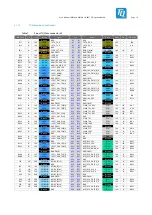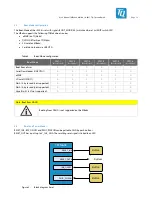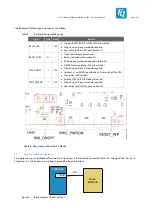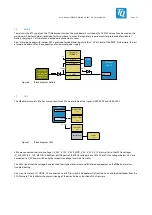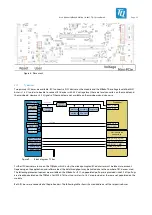
User's Manual l MBa8x UM 0100 l © 2021, TQ-Systems GmbH
Page 32
Any standard-compliant mini-PCIE card can be used, as long as the necessary software drivers are available.
TQMa8x
SIM-
Card
PCIe0 (L1)
LEDs
I2C1
Mini-PCIe-
Card
USB-
Hub
Figure 17:
Block diagram Mini-PCIe
The PCIE_PERST#, PCIE_WAKE# and PCIE_CLKREQ# signals have an IO voltage of 3.3 V. These can therefore be connected directly
to the Mini PCIe card. The PCIE_DISABLE# signal is connected via GPIO.
The differential PCIe signals are elongated and have a differential impedance of 85 Ω.
3.14.11
PCIe M.2
PCIe1 is made available by using a 2230 form factor M.2 slot with "E" coding. I2C is also connected to this slot, as it is to the Mini
PCIe slot.
The connection is the same as for the MB-SMARC-2, with the difference that I2C (pin 58 and 60) is connected with 0 Ω. In
addition, a USB 2.0 port of the USB 3.0 hub is connected.
TQMa8x
PCIe1 (L2)
I2C1
M.2
Slot
USB-Hub
TUSB8041
Figure 18:
Block diagram PCIe M.2
The differential PCIe signals are elongated and have a differential impedance of 85 Ω. Furthermore, the data lines have the
necessary series elements. The signals PCIE_PERST#, PCIE_WAKE# and PCIE_CLKREQ# are connected to the corresponding
connector pins.
3.14.12
PCIe-Clock
Based on previous experience with i.MX processors, the internal PCIe reference clock does not meet JEDEC jitter specifications.
NXP therefore recommends an additional clock driver to provide i.MX 8 and PCIe endpoints with a stable reference clock. The
9FGV0441 clock generator from IDT is used for this purpose. The external reference clock is not optional, but is the only possible
clock source for PCIe modules.
In the circuit diagram of the reference circuit from NXP i.MX8 MEK Platform MCIMX8QM-CPU (EVK) it is noted:
“For simple PCIe Gen1/2 configuration, the CPU's internal REFCLK generator should be used. Peripheral CLKREQ_B should
drive the CPU and no external generator is necessary. For most customer Gen1/2 applications, REFCLK should be automatically
recovered from within the PCIe lanes and not sent separately.”
Furthermore, it is possible to control the clock generator via I2C.

